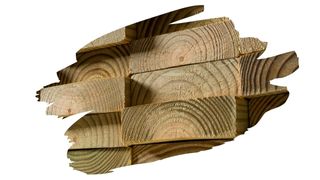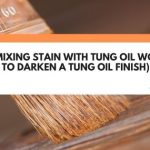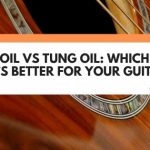It’s no secret that pressure treating wood will help it last longer. Thanks to the wood preservatives infused during this milling process, pressure treated wood is much more resistant to mold.
But, pressure treating is merely one of a myriad of ways we can go about protecting exterior wood from decay. Everything from rain to humidity to the suns strong rays are all going to seriously weather any outdoor lumber.
Which is why a weatherproofing top coat is a great way to protect even pressure treated decking from the elements. But, can a few coats of Tung oil really seal and protect pressure treated wood?
Well, in this post, you will learn all about how treating wood can help timber stave off decay. You will also discover what a microporous finish is — and why it means that Tung oil finishes are far from waterproof.
And keep reading to find out the best wood sealer for exterior pressure treated timber.

This post may contain affiliate links to products that we receive a commission for (at no additional cost to you). Learn more here.
Do You Really Need To Apply An Oil Finish Or Sealant On Pressure Treated Wood?
Generally, pressure treated wood will need a sealant — but this very much depends on the wood species. Pressure treated Oak wood, for example, can last a good long while — even without a sealant.
Related Post: Can You Really Use Untreated Oak For Raised Beds?
You see, pressure treating wood is a process that soaks wood in water-soluble chemical wood preservatives. Those preservatives act like a fungicide, and stave off mold.
But pressure treatment only helps to fight wood rot bacteria — it does not prevent wood from absorbing water. And, if wood absorbs water too frequently, then it can decay sooner rather than later.
This is why a top coating sealant is needed to waterproof wood.
And even naturally rot-resistant wood types, such as Teak wood, can benefit from a UV-blocking sealant.
Can You Use Oil On Treated Wood? Pressure treated wood will absorb penetrating oils. The chemical wood preservatives used to treat this wood, do not seal the surface of wood. So they won’t prevent a penetrating oil-based sealant from soaking into this material.
OK, But Does Tung Oil Work On Exterior Pressure Treated Wood? Will It Waterproof Wood?
Kind of, but let me explain.
First off, Tung oil will soak down into pressure treated wood and cure into a film coat. So, it provides a bit of resistance from moisture.
But, it is not a weatherproofing wood sealer, so it offers next-to-no real protection from outdoor elements.
It doesn’t have any mold-resistant or UV-resistant additives in it either. Tung oil is, at most, a very popular water-repelling finish.
That’s because, due to it’s microporosity, Tung oil finishes can only stop liquid droplets from sinking down into wood.
Now, a microporous wood finish (like Tung oil) can block water droplets. But, condensation, steam, or a mere mist of water vapor, will soak right past a cured Tung oil coat.
So, Tung oil is not great at safeguarding wood from from severe water damage. Which is why you’re better off using a urethane-based sealer if you want real waterproofing.
However, this is all dependent on whether or not you’re using actual pure Tung oil.
You see, many Tung oil finishes sold at stores aren’t actually Tung oil. Rather, these fake-Tung oil finishes contain a blend of thinners, varnish, and solvents. And they throw in natural oils, like Linseed oil or Tung oil, for good measure.
Now, some of these fake-Tung oil wood finishes may contain mold-resistant additives. They might even contain some UV-blocking ingredients to boot.
Yet what they do not contain, (or at least contain very little of), is actual honest-to-goodness pure Tung oil. But, you’ll have to check the product label to be sure.
Related Post: Is Tung Oil A Good Enough Finish For Outdoor Furniture?
Got It. So, Can You Put Tung Oil On Decking?
You could, but it likely won’t last long.
Tung oil is fairly durable in ideal interior conditions. But, if it gets regularly drenched in rainwater or even morning dew, it can begin to wear off.
Which is one of the main reasons why Tung oil wood finishes need to be reapplied every six to twelve months.
Now, Tung oil itself can be used on exterior wood. It doesn’t attract mold (unlike Raw Linseed oil) and it can enhance the appearance of timber. But, you need to think of Tung oil more like an exterior wood preservative, than as a sealant.
Related Post: Can You Use Non Pressure Treated Wood Outside?
OK. So What Is the Best Way to Seal And Preserve Pressure Treated Wood?
Any urethane-based sealant will work best at waterproofing wood. But, if you really want to weatherproof wood, then you need something that also has UV-blockers and fungicides added to it as well.
That is why your best option is going to be Spar Urethane. Also referred to as Spar Varnish, this exterior sealant is used on boats, marine structures, and even outdoor decking.
It is a very low maintenance finish too. Unlike Tung oil, (which needs to be reapplied frequently), you need only reapply Spar Urethane once every five years.
What’s more, a quality Spar Urethane product will also contain UV-blockers, (protecting wood from color-fading due to UV damage), and mildew-resistant additives.
You can find out more about Spar Urethane by reading our post: Can You Use Polyurethane On Tree Bark Decorations?
To Wrap Up, Here Are The 3 Key Takeaways From This Post…
1). Pure Tung oil is a water-repellent wood finish, but it is not waterproof. And it does not contain any UV-blocking ingredients or mold-resistant additives.
2). Tung oil can be used on exterior pressure treated wood. But, it will not be able to give exterior pressure treated wood any significant weatherproofing.
3). If you want to weatherproof exterior wood, use Spar Urethane, or some other similar urethane-based wood sealer.
References:
He Z, Qian J, Qu L, Yan N, Yi S. Effects of Tung oil treatment on wood hygroscopicity, dimensional stability and thermostability. Industrial Crops and Products. 2019 Nov 15;140:111647.



